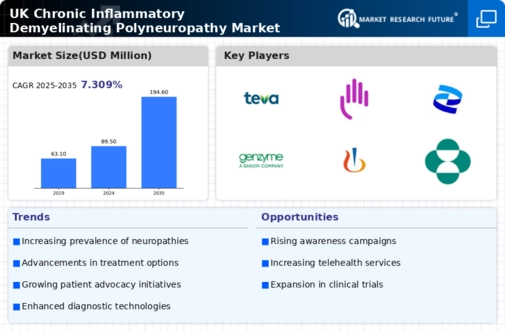Government Initiatives and Funding
Government initiatives in the UK aimed at improving healthcare access and funding for neurological conditions are significantly impacting the chronic inflammatory-demyelinating-polyneuropathy market. The UK government has allocated substantial resources to enhance research and development in the field of neurology, which includes CIDP. For instance, funding for clinical trials and innovative treatment approaches is expected to increase, potentially leading to the introduction of new therapies. This financial support not only encourages pharmaceutical companies to invest in CIDP treatments but also raises awareness among healthcare professionals and patients. As a result, The chronic inflammatory-demyelinating-polyneuropathy market is likely to benefit from these initiatives. This will foster an environment conducive to advancements in care and treatment options.
Rising Demand for Innovative Therapies
The chronic inflammatory-demyelinating-polyneuropathy market is witnessing a rising demand for innovative therapies that address the complexities of the condition. Patients and healthcare providers are increasingly seeking treatments that not only alleviate symptoms but also target the underlying mechanisms of CIDP. This demand is prompting pharmaceutical companies to invest in research and development of novel therapies, including biologics and immunotherapies. The market is likely to see the introduction of new products that offer improved efficacy and safety profiles. As a result, the chronic inflammatory-demyelinating-polyneuropathy market may experience significant growth, driven by the need for more effective treatment options that cater to the diverse needs of patients.
Technological Advancements in Diagnostics
Technological advancements in diagnostic tools are playing a crucial role in shaping the chronic inflammatory-demyelinating-polyneuropathy market. Innovations such as advanced imaging techniques and biomarker identification are enhancing the accuracy of CIDP diagnoses. Improved diagnostic capabilities enable healthcare professionals to identify the condition earlier, which is essential for effective treatment. The integration of artificial intelligence and machine learning in diagnostic processes is also emerging, potentially streamlining patient assessment and management. As diagnostic accuracy improves, more patients are likely to be diagnosed and treated, thereby expanding the chronic inflammatory-demyelinating-polyneuropathy market. This trend indicates a shift towards more precise and timely interventions, which could lead to better patient outcomes.
Growing Patient Advocacy and Support Groups
The emergence of patient advocacy and support groups in the UK is influencing the chronic inflammatory-demyelinating-polyneuropathy market positively. These organizations play a vital role in raising awareness about CIDP, providing education, and advocating for better treatment options. They serve as a bridge between patients and healthcare providers, ensuring that patient voices are heard in the decision-making processes regarding treatment and care. Increased awareness and support can lead to higher diagnosis rates and, consequently, a greater demand for therapies. As these groups continue to grow and mobilize, they are likely to enhance the visibility of CIDP, thereby contributing to the expansion of the chronic inflammatory-demyelinating-polyneuropathy market.
Increasing Prevalence of Neurological Disorders
The chronic inflammatory-demyelinating-polyneuropathy market is experiencing growth due to the rising prevalence of neurological disorders in the UK. Recent estimates suggest that the incidence of chronic inflammatory-demyelinating-polyneuropathy (CIDP) is approximately 1-2 cases per 100,000 individuals annually. This increasing prevalence necessitates enhanced healthcare services and treatment options, thereby driving market demand. As more patients are diagnosed, the need for effective therapies and management strategies becomes paramount. The healthcare system is adapting to these needs, which may lead to increased funding and research initiatives aimed at understanding and treating CIDP. Consequently, this trend is likely to bolster the chronic inflammatory-demyelinating-polyneuropathy market, as healthcare providers seek to address the growing patient population with tailored solutions.


























Leave a Comment